Comparing the Impacts of Location Attributes on Residents’ Preferences and Residential Values in Compact Cities: A Case Study of Hong Kong
Abstract
:1. Introduction
2. Literature Review
2.1. Evaluation Methods on Residential Preference and Residential Value
2.1.1. Evaluation Methods on Residential Preference
2.1.2. Residential Value Evaluation Methods
2.2. Residential Location Choice and Residential Value
3. Case Study Area
4. Methodology
4.1. Overview of the Research Process
4.2. Location Attributes Identification
4.2.1. Accessibility (A)
4.2.2. Public Facilities (P)
4.2.3. Environment (E)
4.2.4. Socio-Demographic (S)
4.3. Residents’ Demand on Neighborhoods
4.3.1. Reliability Interval Method
4.3.2. Survey Data Collection
Questionnaire Design
Pilot Survey
Main Survey
4.4. Influence on Residential Value
4.4.1. Hedonic Price Model
4.4.2. Objective Data Collection
5. Results
5.1. Result of Reliability Interval Method
5.2. Result of Hedonic Price Model
6. Discussion
6.1. Comparision of the Impacts of Location Attributes on Residents’ Demand and Residential Value
6.2. Comparison with Evidence from Previous Studies
7. Conclusions
Author Contributions
Funding
Acknowledgments
Conflicts of Interest
Appendix A
| Name | Type | Number | Proportion | Proportion in Hong Kong |
|---|---|---|---|---|
| Gender | Male | 68 | 44% | 46% |
| Female | 88 | 56% | 54% | |
| Age | 15–24 | 16 | 10% | 12% |
| 15–24 | 50 | 32% | 34% | |
| 45–64 | 61 | 39% | 36% | |
| 65+ | 29 | 19% | 18% | |
| Education | Primary and below | 19 | 12% | 34% |
| Secondary/sixth form | 61 | 39% | 39% | |
| post-secondary | 76 | 49% | 27% | |
| Occupation | Managers and administrators | 13 | 8% | 10% |
| Professionals | 25 | 16% | 7% | |
| Associate professionals | 16 | 10% | 20% | |
| Clerical support workers | 18 | 12% | 14% | |
| Service and sales workers | 22 | 14% | 17% | |
| Craft and related workers | 8 | 5% | 6% | |
| Plant and machine operators and assemblers | 12 | 8% | 4% | |
| Elementary occupations | 14 | 9% | 21% | |
| Skilled agricultural and fishery workers; and occupations not classifiable | 28 | 18% | 0% | |
| Median monthly domestic household income | HK$ 0–6000 | 0 | 0% | 15% |
| HK$ 6001–10,000 | 3 | 2% | 11% | |
| HK$ 10,001–20,000 | 34 | 22% | 39% | |
| HK$ 20,001–30,000 | 40 | 26% | 15% | |
| HK$ 30,001–40,000 | 45 | 29% | 7% | |
| HK$ 40,001–60,000 | 23 | 15% | 7% | |
| HK$ 60,000+ | 11 | 7% | 6% | |
| District | Central and Western | 5 | 3% | 3% |
| Wan Chai | 11 | 7% | 2% | |
| Eastern | 27 | 17% | 8% | |
| Southern | 13 | 8% | 4% | |
| Yau Tsim Mong | 4 | 3% | 5% | |
| Sham Shui Po | 4 | 3% | 6% | |
| Kowloon City | 3 | 2% | 6% | |
| Wong Tai Sin | 10 | 6% | 6% | |
| Kwun Tong | 13 | 8% | 9% | |
| Kwai Tsing | 14 | 9% | 7% | |
| Tsuen Wan | 13 | 8% | 4% | |
| Tuen Mun | 4 | 3% | 7% | |
| Yuen Long | 16 | 10% | 8% | |
| North | 5 | 3% | 4% | |
| Tai Po | 7 | 4% | 4% | |
| Sha Tin | 3 | 2% | 9% | |
| Sai Kung | 3 | 2% | 6% | |
| Island | 1 | 1% | 2% |
References
- Brundtland, G.H. Our common future—Call for action. Environ. Conserv. 1987, 14, 291–294. [Google Scholar] [CrossRef]
- Mohammed, I.; Alshuwaikhat, H.; Adenle, Y. An approach to assess the effectiveness of smart growth in achieving sustainable development. Sustainability 2016, 8, 397. [Google Scholar] [CrossRef] [Green Version]
- Liang, S. Research on China’s urban development strategy based on arable land preservation. J. Urban Plan. Dev. 2010, 137, 329–336. [Google Scholar] [CrossRef]
- Cervero, R.; Murakami, J. Rail and property development in Hong Kong: Experiences and extensions. Urban Stud. 2009, 46, 2019–2043. [Google Scholar] [CrossRef]
- Liao, F.H.; Farber, S.; Ewing, R. Compact development and preference heterogeneity in residential location choice behaviour: A latent class analysis. Urban Stud. 2015, 52, 314–337. [Google Scholar] [CrossRef]
- Bai, Y.; Song, J.; Wu, S.; Lo, S.M.; Bai, G. Exploring the Mechanism of Residential Attractiveness in Compact Urban Areas—A Case Study of Hong Kong. In Proceedings of the 2020 The fifth International Conference on Building Materials and Construction (ICBMC 2020), Tokyo, Japan, 26–29 February 2020. [Google Scholar]
- Lee, J.; Kurisu, K.; An, K.; Hanaki, K. Development of the compact city index and its application to Japanese cities. Urban Stud. 2015, 52, 1054–1070. [Google Scholar] [CrossRef]
- Wu, S.-S.; Zhuang, Y.; Chen, J.; Wang, W.; Bai, Y.; Lo, S.-M. Rethinking bus-to-metro accessibility in new town development: Case studies in Shanghai. Cities 2019, 94, 211–224. [Google Scholar] [CrossRef]
- Shaker, R.R. The spatial distribution of development in Europe and its underlying sustainability correlations. Appl. Geogr. 2015, 63, 304–314. [Google Scholar] [CrossRef]
- Phillips, D.R.; Siu, O.-L.; Yeh, A.G.; Cheng, K.H. Factors influencing older persons’ residential satisfaction in big and densely populated cities in Asia: A case study in Hong Kong. Ageing Int. 2004, 29, 46–70. [Google Scholar] [CrossRef]
- Johnson, J.; Maxwell, B. The role of the Conservation Reserve Program in controlling rural residential development. J. Rural Stud. 2001, 17, 323–332. [Google Scholar] [CrossRef]
- Ardeshiri, A.; Ardeshiri, M.; Radfar, M.; Shormasty, O.H. The values and benefits of environmental elements on housing rents. Habitat Int. 2016, 55, 67–78. [Google Scholar] [CrossRef] [Green Version]
- Paleti, R.; Bhat, C.; Pendyala, R. Integrated model of residential location, work location, vehicle ownership, and commute tour characteristics. Trans. Res. Rec. J. Trans. Res. Board 2013, 2382, 162–172. [Google Scholar] [CrossRef] [Green Version]
- Kim, J.H.; Pagliara, F.; Preston, J. The intention to move and residential location choice behaviour. Urban Stud. 2005, 42, 1621–1636. [Google Scholar] [CrossRef]
- Wong, G.K. A conceptual model of the household’s housing Decision–Making process: The economic perspective. Rev. Urban Reg. Dev. Stud. 2002, 14, 217–234. [Google Scholar] [CrossRef]
- Tse, R.Y. Housing return and the determinants of the capitalization rate: With reference to Hong Kong. J. Prop. Res. 1996, 13, 115–129. [Google Scholar] [CrossRef]
- Hui, S.K.; Cheung, A.; Pang, J. A hierarchical Bayesian approach for residential property valuation: Application to Hong Kong housing market. Int. Real Estate Rev. 2010, 13, 1–29. [Google Scholar]
- Hannah, L.; Kim, K.-H.; Mills, E.S. Land use controls and housing prices in Korea. Urban Stud. 1993, 30, 147–156. [Google Scholar] [CrossRef]
- Fung, Y.; Lee, W. Development of price models for architectural and environmental quality for residential developments in Hong Kong. Habitat Int. 2014, 44, 186–193. [Google Scholar] [CrossRef]
- Cervero, R.; Wu, K.-L. Polycentrism, commuting, and residential location in the San Francisco Bay area. Environ. Plan. A 1997, 29, 865–886. [Google Scholar] [CrossRef]
- Mok, D. Do two-earner households base their choice of residential location on both incomes? Urban Stud. 2007, 44, 723–750. [Google Scholar] [CrossRef]
- Yang, F.; Zeng, G.; Du, C.; Tang, L.; Zhou, J.; Li, Z. Spatial analyzing system for urban land-use management based on GIS and multi-criteria assessment modeling. Prog. Nat. Sci. 2008, 18, 1279–1284. [Google Scholar] [CrossRef]
- Bonaiuto, M.; Fornara, F.; Bonnes, M. Indexes of perceived residential environment quality and neighbourhood attachment in urban environments: A confirmation study on the city of Rome. Landsc. Urban Plan. 2003, 65, 41–52. [Google Scholar] [CrossRef]
- Humpel, N.; Owen, N.; Iverson, D.; Leslie, E.; Bauman, A. Perceived environment attributes, residential location, and walking for particular purposes. Am. J. Prev. Med. 2004, 26, 119–125. [Google Scholar] [CrossRef] [PubMed]
- Balbontin, C.; de Dios Ortúzar, J.; Swait, J.D. Importance of Dwelling, Neighbourhood Attributes in Residential Location Modelling: Best Worst Scaling vs. Discrete Choice. Proc.-Social Behav. Sci. 2014, 160, 92–101. [Google Scholar] [CrossRef] [Green Version]
- Flynn, T.N.; Louviere, J.J.; Peters, T.J.; Coast, J. Best–worst scaling: What it can do for health care research and how to do it. J. Health Econ. 2007, 26, 171–189. [Google Scholar] [CrossRef]
- Li, X.; Yeh, A. Principal component analysis of stacked multi-temporal images for the monitoring of rapid urban expansion in the Pearl River Delta. Int. J. Remote Sens. 1998, 19, 1501–1518. [Google Scholar] [CrossRef]
- Miranda, A.A.; Le Borgne, Y.-A.; Bontempi, G. New routes from minimal approximation error to principal components. Neural Process. Lett. 2008, 27, 197–207. [Google Scholar] [CrossRef] [Green Version]
- Mosadeghi, R.; Warnken, J.; Tomlinson, R.; Mirfenderesk, H. Comparison of Fuzzy-AHP and AHP in a spatial multi-criteria decision making model for urban land-use planning. Comput. Environ. Urban Syst. 2015, 49, 54–65. [Google Scholar] [CrossRef] [Green Version]
- Bai, Y.; Kim, Y. Which Variables are Influential to Evaluate Rapid-Transit Systems in China’s Cities? KIEAE J. 2017, 17, 33–38. [Google Scholar] [CrossRef]
- Benítez, J.; Delgado-Galván, X.; Izquierdo, J.; Pérez-García, R.J.A.M. Computation, Improving consistency in AHP decision-making processes. Appl. Math. Comput. 2012, 219, 2432–2441. [Google Scholar]
- Ergu, D.; Kou, G.; Peng, Y.; Yang, X. Simulation experiments for improving the consistency ratio of reciprocal matrices. Int. J. Comput. Commun. Control 2014, 9, 408–418. [Google Scholar] [CrossRef]
- Lo, S.; Zhao, C.; Cheng, W.Y. Perceptions of building professionals on sustainable development: A comparative study between Hong Kong and Shenyang. Energy Build. 2006, 38, 1327–1334. [Google Scholar] [CrossRef]
- Yiu, C.; Ho, H.; Lo, S.; Hu, B. Performance evaluation for cost estimators by reliability interval method. J. Constr. Eng. Manag. 2005, 131, 108–116. [Google Scholar] [CrossRef]
- Lo, S.; Hu, B.; Liu, M.; Yuen, K. On the use of reliability interval method and grey relational model for fire safety ranking of existing buildings. Fire Technol. 2005, 41, 255–270. [Google Scholar] [CrossRef]
- Vessali, K.V. Land use impacts of rapid transit: A review of the empirical literature. Berkeley Plan. J. 1996, 11. [Google Scholar] [CrossRef] [Green Version]
- McMillen, D.P.; McDonald, J. Reaction of house prices to a new rapid transit line: Chicago’s midway line, 1983–1999. Real Estate Econ. 2004, 32, 463–486. [Google Scholar] [CrossRef]
- Tian, L. Impacts of transport projects on residential property values in China: Evidence from two projects in Guangzhou. J. Prop. Res. 2006, 23, 347–365. [Google Scholar] [CrossRef]
- Bailey, M.J.; Muth, R.F.; Nourse, H.O. A regression method for real estate price index construction. J. Am. Stat. Assoc. 1963, 58, 933–942. [Google Scholar] [CrossRef]
- Kim, K.; Lahr, M.L. The impact of H udson-B ergen L ight R ail on residential property appreciation. Pap. Reg. Sci. 2014, 93, S79–S97. [Google Scholar] [CrossRef] [Green Version]
- Hill, R.C.; Knight, J.R.; Sirmans, C. Estimating capital asset price indexes. Rev. Econ. Stat. 1997, 79, 226–233. [Google Scholar] [CrossRef]
- Griliches, Z. Hedonic Price Indexes for Automobiles: An Econometric of Quality Change. In The Price Statistics of the Federal Government; NBER: Cambridge, MA, USA, 1961; pp. 173–196. [Google Scholar]
- Schläpfer, F.; Waltert, F.; Segura, L.; Kienast, F. Valuation of landscape amenities: A hedonic pricing analysis of housing rents in urban, suburban and periurban Switzerland. Landsc. Urban Plan. 2015, 141, 24–40. [Google Scholar] [CrossRef]
- Cervero, R. Effects of light and commuter rail transit on land prices: Experiences in San Diego County. J. Trans. Res. Forum 2010, 43, 121–138. [Google Scholar] [CrossRef]
- Bae, C.-H.C.; Jun, M.-J.; Park, H. The impact of Seoul’s subway Line 5 on residential property values. Trans. Policy 2003, 10, 85–94. [Google Scholar] [CrossRef]
- Zheng, S.; Kahn, M.E. Land and residential property markets in a booming economy: New evidence from Beijing. J. Urban Econ. 2008, 63, 743–757. [Google Scholar] [CrossRef]
- Qin, Z.; Yu, Y.; Liu, D. The Effect of HOPSCA on Residential Property Values: Exploratory Findings from Wuhan, China. Sustainability 2019, 11, 471. [Google Scholar] [CrossRef] [Green Version]
- Næss, P. Accessibility, activity participation and location of activities: Exploring the links between residential location and travel behaviour. Urban Stud. 2006, 43, 627–652. [Google Scholar] [CrossRef]
- Earnhart, D. Combining revealed and stated preference methods to value environmental amenities at residential locations. Land Econ. 2001, 77, 12–29. [Google Scholar] [CrossRef] [Green Version]
- Smith, B.; Olaru, D. Lifecycle stages and residential location choice in the presence of latent preference heterogeneity. Environ. Plan. A 2013, 45, 2495–2514. [Google Scholar] [CrossRef]
- Vergeer, P.; Van Den Berg, L.; Roelofs, J.; Ouborg, N. Single-family versus multi-family introductions. Plant Biol. 2005, 7, 509–515. [Google Scholar] [CrossRef]
- Kim, S.-S.; Yang, I.-H.; Yeo, M.-S.; Kim, K.-W. Development of a housing performance evaluation model for multi-family residential buildings in Korea. Build. Environ. 2005, 40, 1103–1116. [Google Scholar] [CrossRef]
- Jim, C.Y.; Chen, W.Y. Value of scenic views: Hedonic assessment of private housing in Hong Kong. Landsc. Urban Plan. 2009, 91, 226–234. [Google Scholar] [CrossRef]
- Tapsuwan, S.; Polyakov, M.J.S.; Resources, N. Correctly specifying environmental assets in spatial hedonic pricing models. Soc. Nat. Resour. 2016, 29, 233–249. [Google Scholar] [CrossRef]
- Hong Kong in Figures. Available online: https://www.statistics.gov.hk/pub/B10100062019AN19B0100.pdf (accessed on 25 September 2019).
- Hong Kong Planning Standards and Guildlines. Available online: https://www.pland.gov.hk/pland_en/tech_doc/hkpsg/full/pdf/ch1.pdf (accessed on 25 September 2019).
- Land Utilization in Hong Kong 2018. Available online: https://www.pland.gov.hk/pland_en/info_serv/statistic/landu.html (accessed on 25 September 2019).
- Public Transport Strategy Study. Available online: https://www.td.gov.hk/filemanager/en/publication/ptss_final_report_eng.pdf (accessed on 25 September 2019).
- Lui, L.; Kim, Y. Use and perception of podium gardens in residential neighborhoods in Hong Kong. Sustainability 2017, 9, 57. [Google Scholar] [CrossRef] [Green Version]
- Lai, L.W.-C.; Fong, K. Town Planning Practice: Context, Procedures and Statistics for Hong Kong; Hong Kong University Press: Hong Kong, China, 2000; Volume 1. [Google Scholar]
- Map of Districts in Hong Kong. Available online: http://www.legco.gov.hk/yr10-11/chinese/panels/ca/papers/cacb2-2175-ec.pdf (accessed on 29 April 2020).
- MTR System Map. Available online: http://www.mtr.com.hk/archive/en/services/routemap.pdf (accessed on 29 April 2020).
- Inoa, I.A.; Picard, N.; De Palma, A. Effect of an accessibility measure in a model for choice of residential location, workplace, and type of employment. Math. Popul. Stud. 2015, 22, 4–36. [Google Scholar] [CrossRef]
- Hui, E.C.; Chau, C.; Pun, L.; Law, M. Measuring the neighboring and environmental effects on residential property value: Using spatial weighting matrix. Build. Environ. 2007, 42, 2333–2343. [Google Scholar] [CrossRef]
- Tse, R.Y.; Love, P.E. Measuring residential property values in Hong Kong. Prop. Manag. 2000, 18, 366–374. [Google Scholar] [CrossRef] [Green Version]
- Li, H.; Wei, Y.D.; Yu, Z.; Tian, G. Amenity, accessibility and housing values in metropolitan USA: A study of Salt Lake County, Utah. Cities 2016, 59, 113–125. [Google Scholar] [CrossRef]
- Boynton, P.M. Hands-on guide to questionnaire research: Administering, analysing, and reporting your questionnaire. BMJ Br. Med. J. 2004, 328, 1372. [Google Scholar] [CrossRef] [Green Version]
- Population. Available online: http://www.census2017.gov.hk/en/index.html/ (accessed on 13 November 2018).
- 2018 Annual Transport Digest. Available online: https://www.td.gov.hk/mini_site/atd/2018/en/section5_2.html (accessed on 25 September 2019).
- Hong Kong 2030+: Planning and Urban Design for a Liveable High-Density City. Available online: https://www.hk2030plus.hk/document/Planning%20and%20Urban%20Design%20for%20a%20Liveable%20High-Density%20City_Eng.pdf (accessed on 25 September 2019).
- Madeddu, M.; Zhang, X. Harmonious spaces: The influence of Feng Shui on urban form and design. J. Urban Des. 2017, 22, 709–725. [Google Scholar] [CrossRef]
- Hong Kong 2030+: Towards a Planning Vision and Strategy Transcending 2030. Available online: https://www.hk2030plus.hk/document/Conceptual%20Spatial%20Framework_Eng.pdf (accessed on 25 September 2019).
- Jim, C.Y.; Chen, W.Y. External effects of neighbourhood parks and landscape elements on high-rise residential value. Land Use Policy 2010, 27, 662–670. [Google Scholar] [CrossRef]
- Yang, Y.; o’Neill, K. Understanding factors affecting people’s attitudes toward living in compact and mixed-use environments: A case study of a New Urbanist project in Eugene, Oregon, USA. J. Urban. Int. Res. Placemaking Urban Sustain. 2014, 7, 1–22. [Google Scholar] [CrossRef]
- Howley, P. Attitudes towards compact city living: Towards a greater understanding of residential behaviour. Land Use Policy 2009, 26, 792–798. [Google Scholar] [CrossRef]
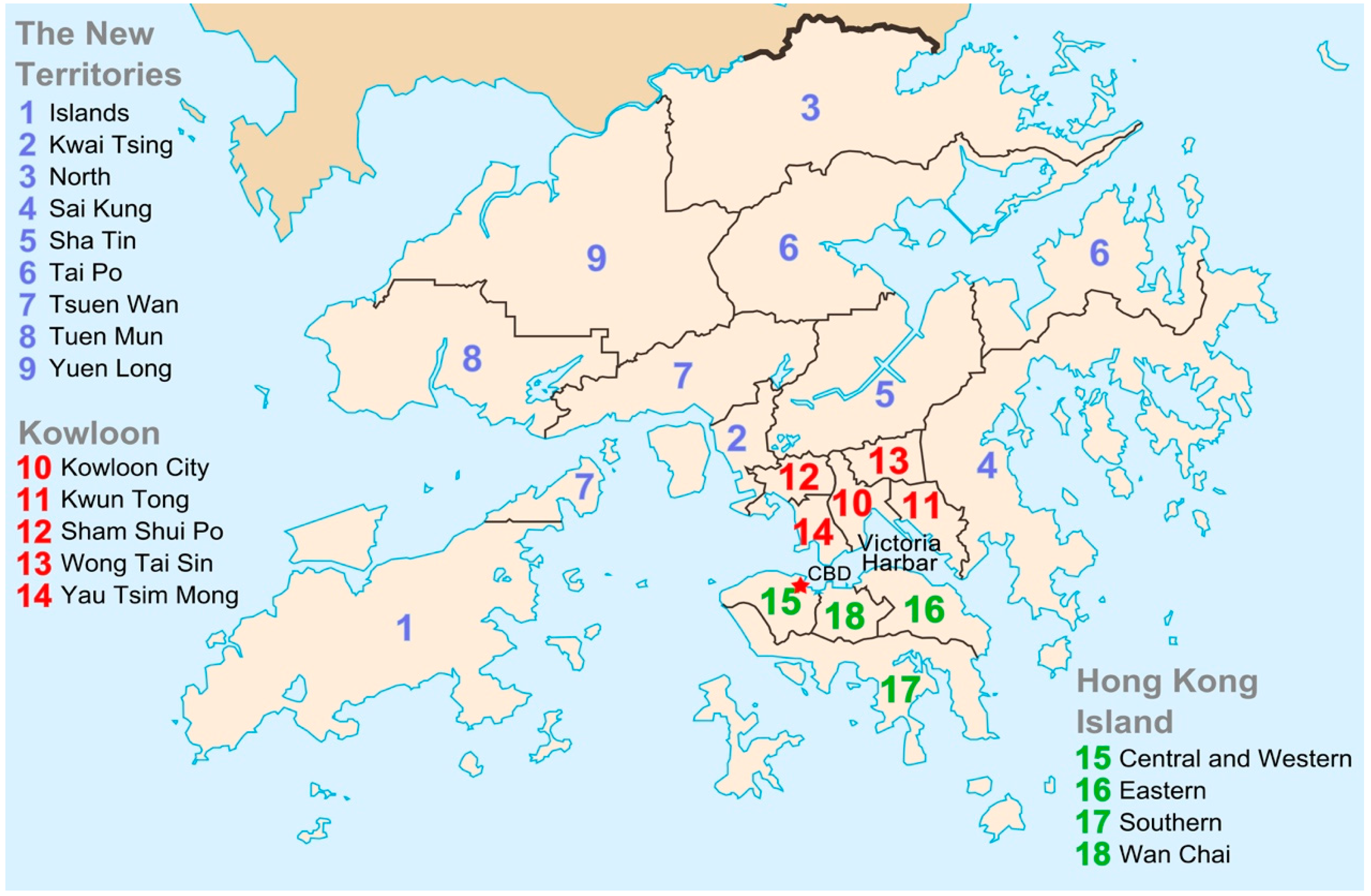

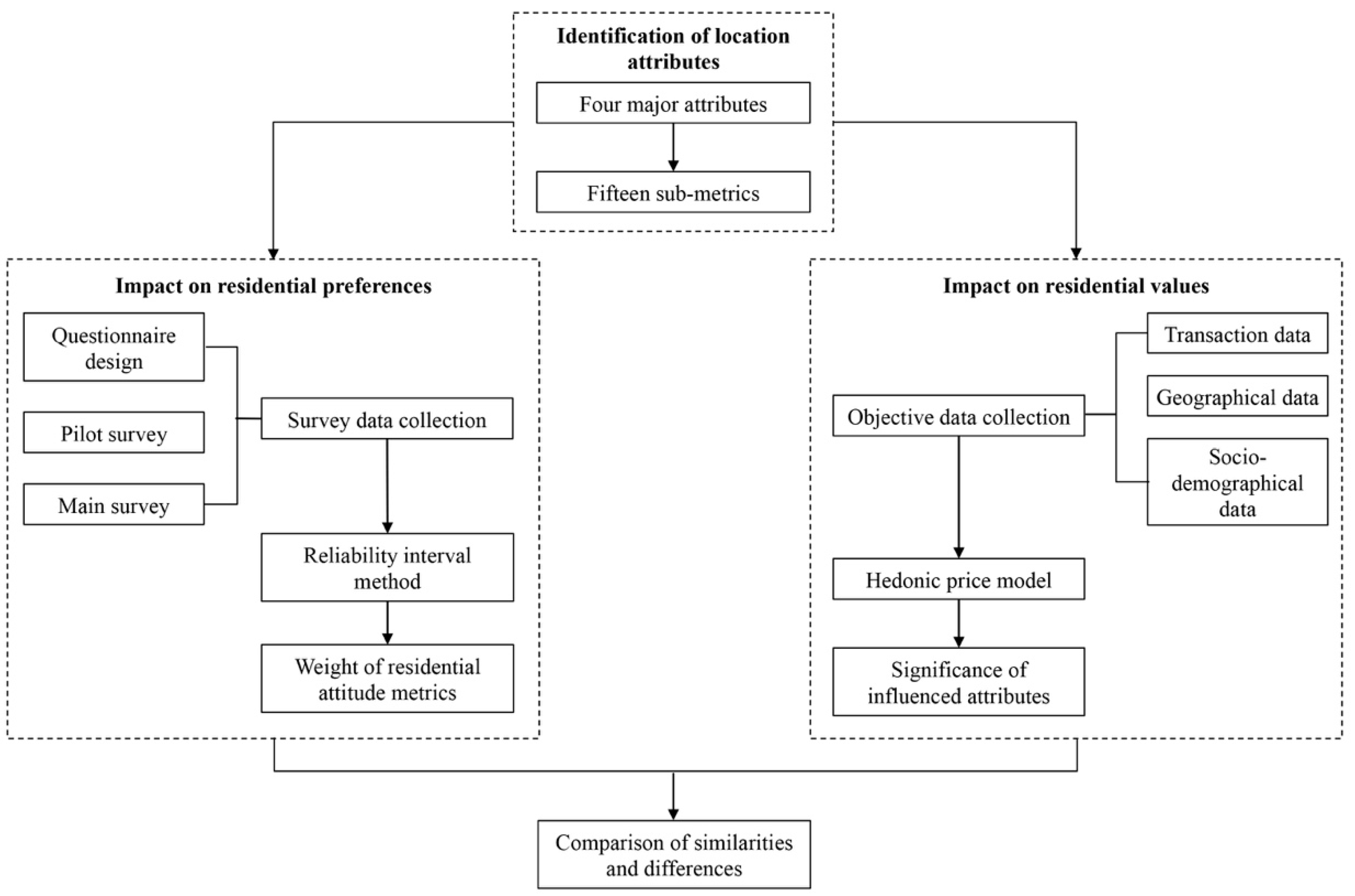


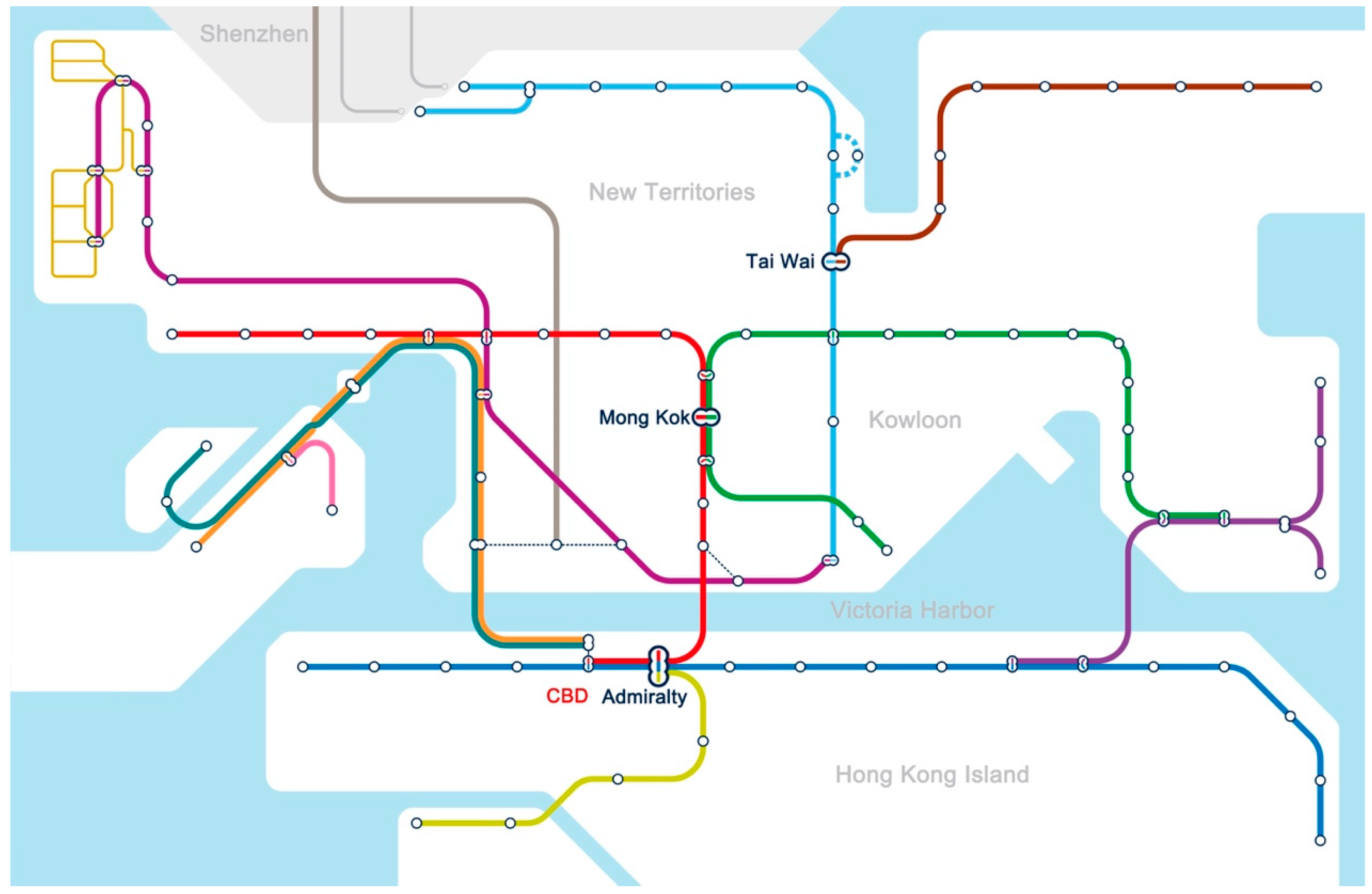
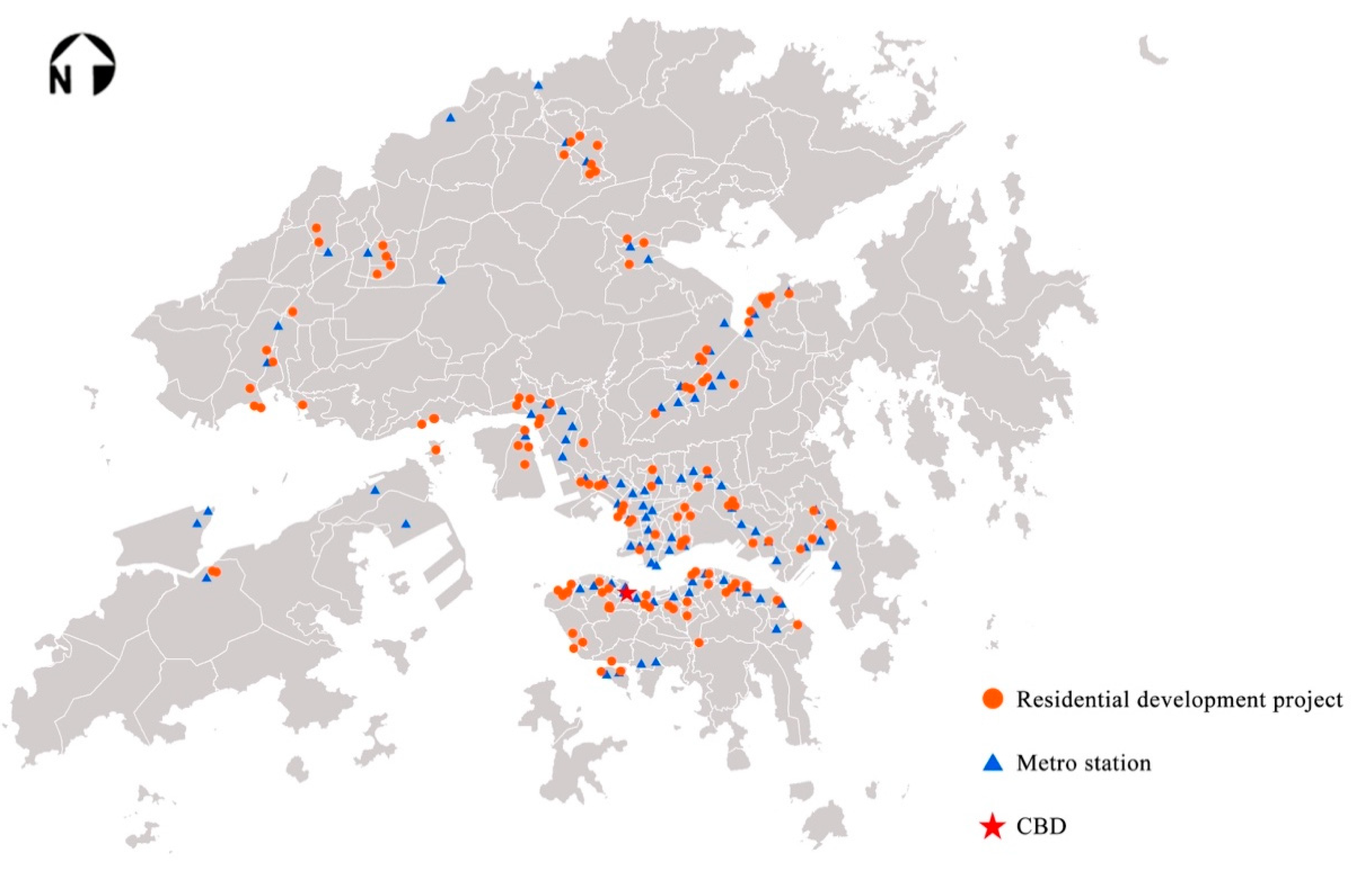
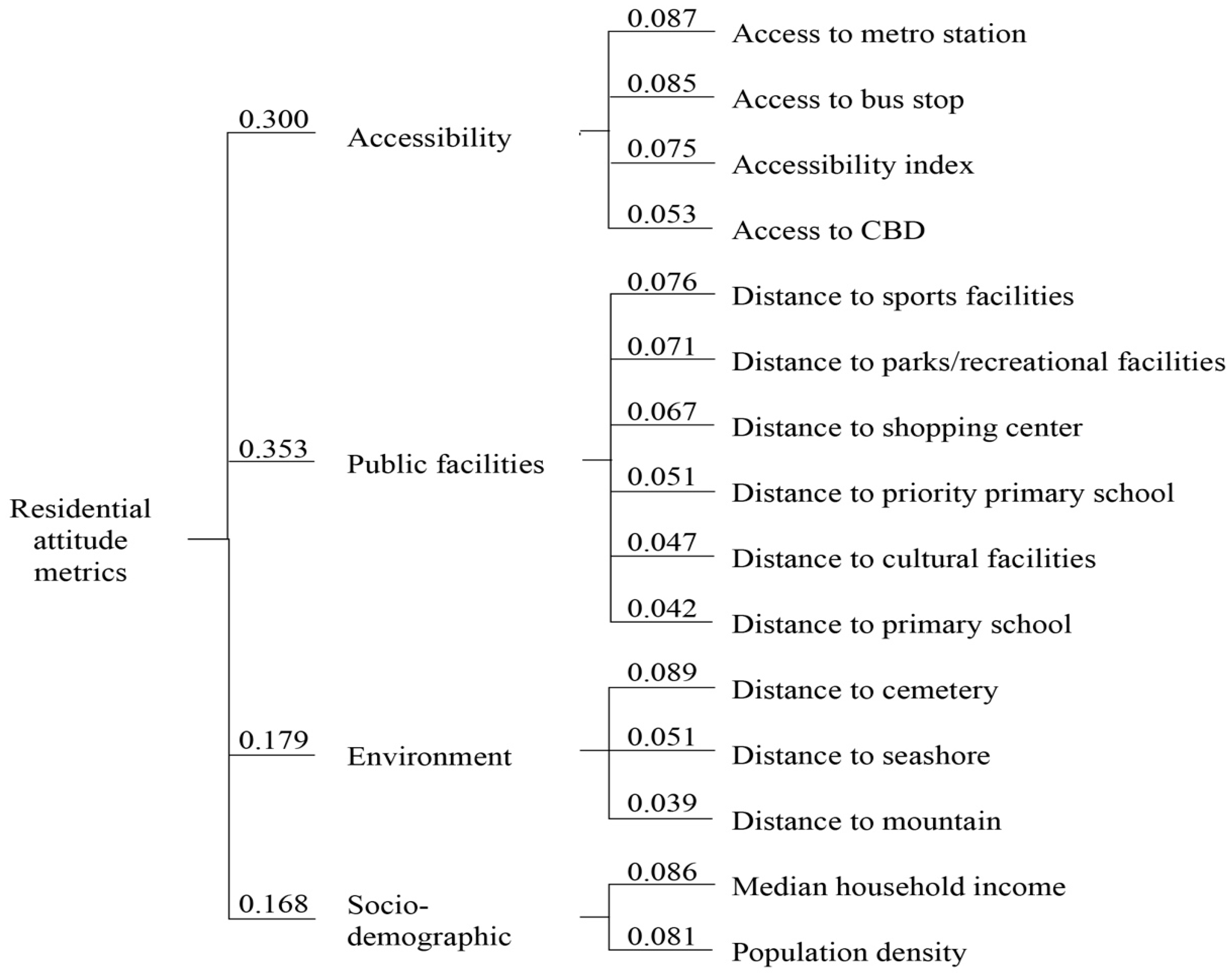
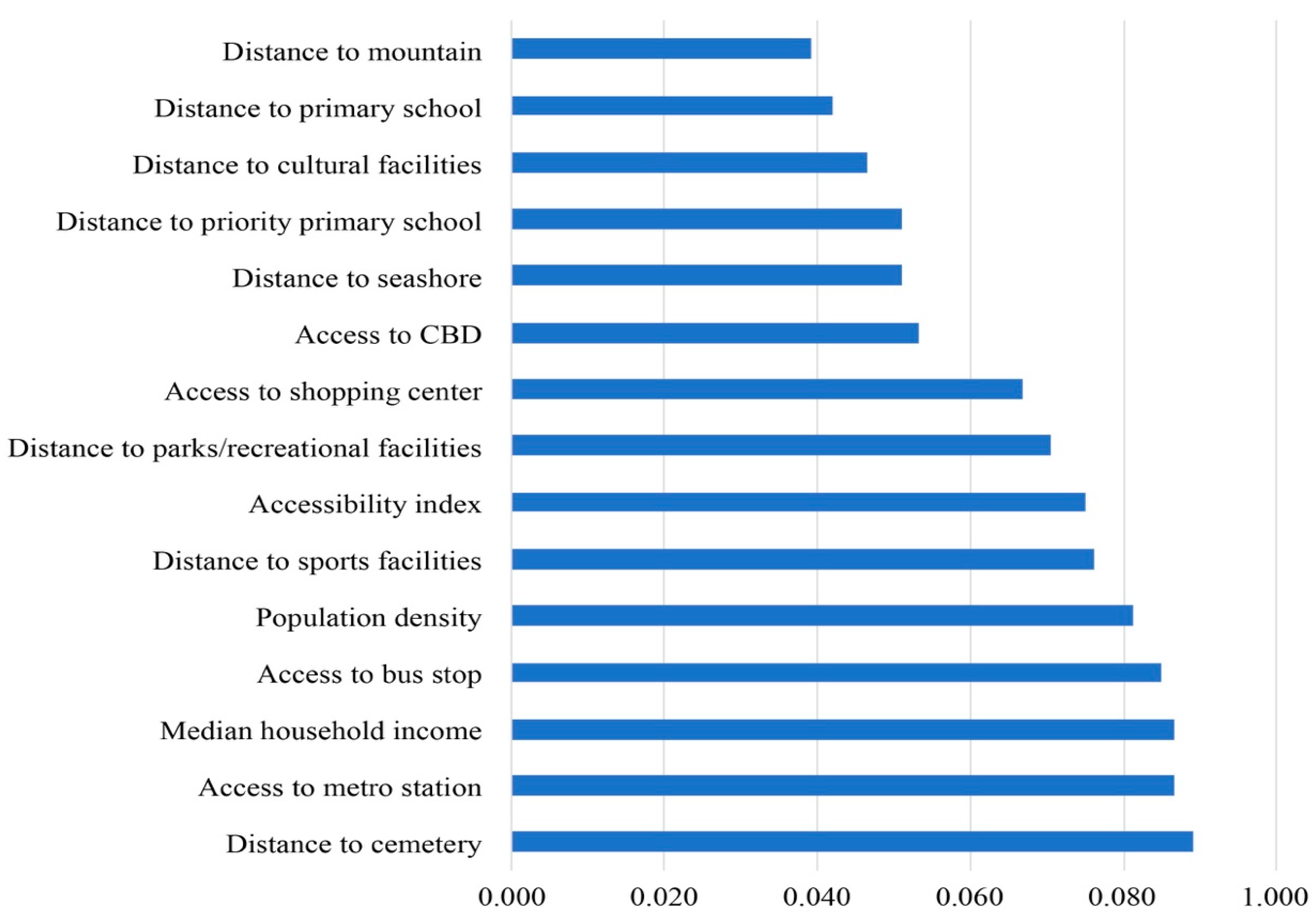
| Attribute | Sub-Metrics | Name | Description |
|---|---|---|---|
| Accessibility | Accessibility index | AI | Accessibility of residence zone i to all employment zone j |
| Access to metro station | METRO | Network distance to the nearest metro station | |
| Access to bus stop | BUS | Network distance to the nearest bus stop | |
| Access to CBD | CBD | Network distance to the CBD | |
| Public facilities | Distance to shopping center | SC | Network distance to the nearest shopping center |
| Distance to primary school | PS | Network distance to the nearest primary school | |
| Distance to priority primary school | PPS | Network distance to the nearest top 50 primary schools | |
| Distance to parks/recreational facilities | PARK | Network distance to the nearest parks/recreational facilities | |
| Distance to sports facilities | SPORT | Network distance to the nearest sports facilities | |
| Distance to cultural facilities | CUL | Network distance to the nearest cultural facilities | |
| Environment | Distance to seashore | SEA | Network distance to the nearest seashore |
| Distance to mountain | MOUN | Network distance to the nearest mountain | |
| Distance to cemetery | CEME | Network distance to the cemetery | |
| Socio-demographic | Population density | PD | Population density in residential zone i |
| Median household income | MHI | Monthly median household income in residential zone i |
| Intensity of Importance | Definition |
|---|---|
| 0 | No importance |
| 1 | Little importance |
| 3 | Moderate importance |
| 5 | Strong importance |
| 7 | Very strong importance |
| 2, 4, 6 | Immediate values between preceding scale values |
| Data Name | Data Resource | Unit |
|---|---|---|
| Residential value | Centaline database | HK$/m2 |
| Accessibility index | Hong Kong Population Census; Google Maps | persons per km |
| Access to metro station | Google Maps; Open Street Map | km |
| Access to bus stop | Google Maps; Open Street Map | km |
| Access to CBD | Google Maps; Open Street Map | km |
| Distance to shopping center | Google Maps; Open Street Map | km |
| Distance to primary school | GeoInfo Map; Google Maps | km |
| Distance to priority primary school | GeoInfo Map; Google Maps; Evaluation of competitiveness of secondary school/primary school/kindergarten education in Hong Kong | km |
| Distance to parks/recreational facilities | GeoInfo Map; Google Maps | km |
| Distance to sport facilities | GeoInfo Map; Google Maps | km |
| Distance to cultural facilities | GeoInfo Map; Google Maps | km |
| Distance to seashore | Open Street Map | km |
| Distance to mountain | Open Street Map | km |
| Distance to cemetery | Open Street Map | km |
| Population density | Hong Kong Population Census | persons per km2 |
| Median household income | Hong Kong Population Census | HK$/month |
| Age (Years) | Sample Size in This Survey | Proportion in This Survey | Total Population in Hong Kong | Proportion in Hong Kong |
|---|---|---|---|---|
| 15–24 | 16 | 10% | 785,981 | 12% |
| 25–44 | 50 | 32% | 2,229,566 | 34% |
| 45–64 | 61 | 39% | 2,328,430 | 36% |
| 65+ | 29 | 19% | 1,163,153 | 18% |
| Total | 156 | 100% | 6,507,130 | 100% |
| Attributes | Sub-Metrics | Interval Grade | Grade Eigenvalue | Weight | Reliability | CV | IV |
|---|---|---|---|---|---|---|---|
| Accessibility | AI | [3.8, 4.8] | 4.3 | 0.075 | 0.38 | 3.28 | 5.04 |
| METRO | [4.4, 5.5] | 5.0 | 0.087 | 0.46 | 2.33 | 3.86 | |
| BUS | [4.3, 5.4] | 4.9 | 0.085 | 0.44 | 2.43 | 4.03 | |
| CBD | [2.5, 3.6] | 3.0 | 0.053 | 0.48 | 2.25 | 3.80 | |
| Public facilities | SC | [3.3, 4.3] | 3.8 | 0.067 | 0.41 | 3.05 | 4.82 |
| PS | [1.9, 2.9] | 2.4 | 0.042 | 0.40 | 2.81 | 4.48 | |
| PPS | [2.4, 3.4] | 2.9 | 0.051 | 0.35 | 3.54 | 5.44 | |
| PARK | [3.5, 4.5] | 4.0 | 0.071 | 0.36 | 3.39 | 5.26 | |
| SPORT | [3.8, 4.9] | 4.3 | 0.076 | 0.33 | 3.03 | 4.77 | |
| CUL | [2.1, 3.2] | 2.7 | 0.047 | 0.39 | 3.04 | 4.82 | |
| Environment | SEA | [2.4, 3.4] | 2.9 | 0.051 | 0.44 | 3.17 | 4.94 |
| MOUN | [1.7, 2.8] | 2.2 | 0.039 | 0.37 | 2.79 | 4.46 | |
| CEME | [4.6, 5.6] | 5.1 | 0.089 | 0.32 | 2.41 | 4.07 | |
| Socio-demographic | PD | [4.1, 5.2] | 4.7 | 0.081 | 0.46 | 2.10 | 3.60 |
| MHI | [4.4, 5.5] | 4.9 | 0.086 | 0.50 | 1.84 | 3.25 |
| Attribute | Variable | Minimum | Maximum | Mean | Standard Deviation |
|---|---|---|---|---|---|
| Value | VALUE | 5584.20 | 15,768.30 | 9722.5293 | 2466.9615 |
| Accessibility | AI | 100.94 | 383.09 | 234.3628 | 70.57186 |
| METRO | 0.08 | 8.30 | 1.2433 | 1.65959 | |
| BUS | 0.00 | 0.17 | 0.0494 | 0.03584 | |
| CBD | 1.30 | 36.70 | 15.8198 | 10.18707 | |
| Public facilities | SC | 0.10 | 8.30 | 0.4041 | 0.82951 |
| PS | 0.07 | 2.70 | 0.5593 | 0.38075 | |
| PPS | 0.22 | 12.70 | 3.3594 | 3.47421 | |
| PARK | 0.11 | 8.20 | 0.8265 | 0.92839 | |
| SPORT | 0.06 | 6.00 | 1.0653 | 1.20858 | |
| CUL | 0.06 | 10.30 | 1.2630 | 1.78701 | |
| Environment | SEA | 0.01 | 5.47 | 1.2785 | 1.44220 |
| MOUN | 0.06 | 4.63 | 1.3860 | 1.00115 | |
| CEME | 0.18 | 6.99 | 2.5023 | 1.81233 | |
| Socio-demographic | PD | 101.00 | 175,338.00 | 27,995.3362 | 40,579.41621 |
| MHI | 4778.00 | 162,341.00 | 38,802.9741 | 25,357.32130 |
| Variable | Coefficient | Standard Error | t | Sig. |
|---|---|---|---|---|
| Accessibility | ||||
| METRO | −0.033 | 0.012 | −2.884 | 0.005 |
| BUS | −0.384 | 0.36 | −1.067 | 0.288 |
| SC | 0.033 | 0.018 | 1.832 | 0.070 |
| CBD | −0.016 | 0.002 | −10.166 | 0.000 |
| Public facilities | ||||
| PS | 0.008 | 0.034 | 0.239 | 0.811 |
| PPS | −0.006 | 0.005 | −1.151 | 0.252 |
| SPORT | 0.004 | 0.015 | 0.266 | 0.791 |
| Environment | ||||
| SEA | 0.003 | 0.011 | 0.269 | 0.788 |
| MOUN | 0.009 | 0.013 | 0.653 | 0.515 |
| CEME | 0.004 | 0.008 | 0.517 | 0.606 |
| Socio-demographic | ||||
| lnMHI | 0.068 | 0.026 | 2.624 | 0.010 |
| (Constant) | 11,438.381 | 588.989 | 19.42 | 0.000 |
| Summary Statistics | ||||
| Number of observations = 116 | ||||
| F Statistic (prob.) = 30.648 (0.000) | ||||
| R2 = 0.764 | ||||
© 2020 by the authors. Licensee MDPI, Basel, Switzerland. This article is an open access article distributed under the terms and conditions of the Creative Commons Attribution (CC BY) license (http://creativecommons.org/licenses/by/4.0/).
Share and Cite
Bai, Y.; Song, J.; Wu, S.; Wang, W.; Lo, J.T.Y.; Lo, S.M. Comparing the Impacts of Location Attributes on Residents’ Preferences and Residential Values in Compact Cities: A Case Study of Hong Kong. Sustainability 2020, 12, 4867. https://doi.org/10.3390/su12124867
Bai Y, Song J, Wu S, Wang W, Lo JTY, Lo SM. Comparing the Impacts of Location Attributes on Residents’ Preferences and Residential Values in Compact Cities: A Case Study of Hong Kong. Sustainability. 2020; 12(12):4867. https://doi.org/10.3390/su12124867
Chicago/Turabian StyleBai, Yunxi, Jusheng Song, Shanshan Wu, Wei Wang, Jacqueline T. Y. Lo, and S. M. Lo. 2020. "Comparing the Impacts of Location Attributes on Residents’ Preferences and Residential Values in Compact Cities: A Case Study of Hong Kong" Sustainability 12, no. 12: 4867. https://doi.org/10.3390/su12124867
APA StyleBai, Y., Song, J., Wu, S., Wang, W., Lo, J. T. Y., & Lo, S. M. (2020). Comparing the Impacts of Location Attributes on Residents’ Preferences and Residential Values in Compact Cities: A Case Study of Hong Kong. Sustainability, 12(12), 4867. https://doi.org/10.3390/su12124867







